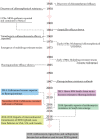Extensively Drug-Resistant (XDR) Typhoid: Evolution, Prevention, and Its Management
- PMID: 32462008
- PMCID: PMC7212280
- DOI: 10.1155/2020/6432580
Extensively Drug-Resistant (XDR) Typhoid: Evolution, Prevention, and Its Management
Abstract
Typhoid fever is the result of a human host-restricted Salmonella enteric serotype typhi infection that causes enteric fever. Around 21 million people contract typhoid annually, with Pakistan's inhabitants at most risk amongst Asian countries where typhoid remains prevalent. Decades of indiscriminate antibiotic usage has driven the evolution of multidrug-resistant strains and more recently, extensively drug-resistant (XDR) strains of Salmonella enteric serotype typhi. Current reports of extensively drug-resistant typhoid fever outbreak in Pakistan are not only a major concern for Pakistan but also for health authorities worldwide: intercontinental transmission, spread, and replacement of native strains in neighboring countries and a major impediment to Pakistani health care management. The WHO records that there are 5274 cases of extensively drug-resistant (XDR) typhoid fever out of a total of 8188 total cases of typhoid fever reported in Pakistan. The last remaining feasible oral antibiotic that XDR typhoid remains susceptible to is azithromycin; this is a cause of major concern. Additionally, several cases of XDR typhoid fever have also been reported in patients travelling from Pakistan to the USA, UK, and Canada. This review article attempts to raise the issue of XDR typhoid with respect to its epidemiology, prevention, management, and future outlook and stresses a better understanding of antimicrobial stewardship and general surveillance of the disease. Although progress is being made to combat XDR typhoid locally, efficient, unified efforts on a national and international scale are required to contain the XDR outbreak before it is no longer manageable and leads us back to the preantibiotic era.
Copyright © 2020 Javed Akram et al.
Conflict of interest statement
The authors declare no conflict of interest.
Figures



References
Publication types
MeSH terms
Substances
LinkOut - more resources
Full Text Sources

